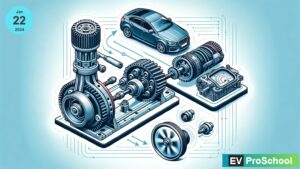The discussion around electric vehicle (EV) technology is evolving rapidly, and one of the debates gaining traction is whether multi-speed gearboxes can deliver better range than traditional single-speed setups. While most electric vehicles currently use single-speed gearboxes, a few manufacturers have started experimenting with multi-speed transmissions. Let’s dive into this topic to understand the potential benefits and trade-offs of multi-speed gearboxes in electric vehicles and whether they could really help extend the driving range.
Understanding Single-Speed vs. Multi-Speed Gearboxes in EVs
In traditional internal combustion engine (ICE) vehicles, multi-speed transmissions are necessary because engines have a narrow power band. Different gears are used to keep the engine within an optimal RPM range to deliver power efficiently at various speeds. Electric motors, however, work differently. They produce a broad torque range, offering near-instantaneous torque from a standstill and maintaining efficiency over a wider range of speeds. As a result, EVs can often rely on single-speed gearboxes without sacrificing performance.
But what about efficiency and range? That’s where the debate arises. While single-speed gearboxes are simpler and more cost-effective, multi-speed transmissions could optimize an electric motor’s performance, potentially improving energy use and range.
Advantages of Single-Speed Gearboxes
- Simplicity: Single-speed gearboxes have fewer components, making them lighter, less expensive, and easier to manufacture and maintain.
- Efficiency: Since electric motors are inherently efficient across a wide range of speeds, a single-speed gearbox often provides a good balance of performance and energy consumption without the complexity of additional gears.
- Durability: Fewer moving parts in a single-speed gearbox mean less wear and tear, contributing to longer-lasting powertrains with minimal maintenance.
Multi-Speed Gearboxes: A New Approach
Multi-speed gearboxes in EVs, though not widely adopted, are starting to be explored by some automakers, such as Porsche in their Taycan and Rimac in their hypercars. These vehicles incorporate two-speed gearboxes, providing better torque at lower speeds and higher efficiency at higher speeds.
Key Advantages of Multi-Speed Gearboxes
- Optimized Efficiency: Multi-speed gearboxes can allow the motor to operate at its most efficient speed across a wider range of driving conditions. This can result in reduced energy consumption during high-speed driving or steep hill climbs, theoretically extending the vehicle’s range.
- Improved Performance: A multi-speed gearbox can offer better low-speed acceleration while maintaining efficiency at high speeds. This can be particularly beneficial in sports-oriented EVs where performance is a priority.
- Range Extension: In theory, if a multi-speed transmission can keep the motor in its most efficient operating range more often, it could result in increased range, especially during highway driving, where higher speeds are sustained.
The Range Debate: Which is Better?
The potential for multi-speed gearboxes to extend range depends largely on the type of driving. Here’s how it breaks down:
- City Driving: In stop-and-go traffic, a single-speed gearbox is likely more than sufficient. Electric motors excel at low-speed, high-torque situations without the need for multiple gears. The efficiency gains from a multi-speed gearbox might not be as noticeable in urban environments.
- Highway Driving: At higher speeds, electric motors tend to operate less efficiently, and this is where a multi-speed gearbox could make a difference. By allowing the motor to shift into a more efficient gear for sustained high-speed driving, a multi-speed gearbox could reduce energy consumption and extend range.
However, the improvements in range from a multi-speed gearbox might not be drastic enough to outweigh the increased complexity, cost, and weight of such systems. The trade-off between range gains and these additional factors is why single-speed gearboxes are still dominant in the EV market.
The Future of Multi-Speed Gearboxes in EVs
While multi-speed transmissions are still rare in electric vehicles, they could become more common as manufacturers continue to push the boundaries of EV performance. For now, the range differences between single-speed and multi-speed EVs are marginal for most daily driving scenarios. However, for high-performance EVs or vehicles designed for long-distance highway driving, multi-speed gearboxes could offer noticeable benefits.
Conclusion
The use of multi-speed gearboxes in electric vehicles presents an intriguing possibility for improving range, particularly at higher speeds. While single-speed gearboxes offer simplicity, reliability, and sufficient efficiency for most driving situations, multi-speed transmissions could give EVs a slight edge in range, especially on highways. Ultimately, the choice between a single-speed or multi-speed gearbox depends on the design goals of the vehicle whether it’s aimed at maximizing simplicity and cost-effectiveness or enhancing performance and range in specific driving conditions.
As EV technology continues to evolve, we may see more advancements in transmission systems, with automakers experimenting to find the perfect balance between performance, efficiency, and range.



